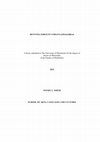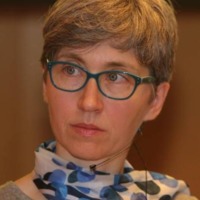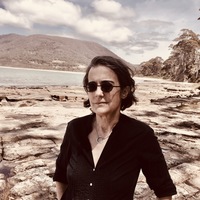PhD Thesis by Wendy Ligon Smith

(see link for full text)
Mariano Fortuny y Madrazo (1871-1949) was a Spanish-born polymath who, ... more (see link for full text)
Mariano Fortuny y Madrazo (1871-1949) was a Spanish-born polymath who, though mostly remembered for his historically inspired fashion designs, was first trained as a painter in Paris and would become a lighting and set designer, photographer, costume designer, and inventor. Working in Venice at the turn of the 20th century with an insatiable appetite for the historic, the notoriously secretive artist was often called a magician. Fortuny was able to produce a realistic night sky using his own electric stage lighting system. He inverted traditional photographic processes by printing horizontally with natural light from the window in his darkroom. And his most enigmatic creation is a series of rarely seen photographic prints made in a lightless process where mounds of damp fabric were pressed onto sensitized paper to form an abstract multiplicity of wrinkles. Despite being an inventor who relied on technological advancements and experiments, Fortuny’s deeply historical temperament is evident in his own declaration: ‘Nothing is new in this world, so I do not pretend to bring new ideas’.
He invented a machine for permanently pressing the Classical pleats of his delicate silk Delphos gown and with painted stencilling he re-created the glittering patterns of woven brocades and damasks from the Italian Renaissance – often copied from 16th-century painting. Marcel Proust utilized these garments, which remained largely unchanged over forty years of production, as Venetian emblems of memory in À la recherche du temps perdu, where they conjure Carpaccio’s exquisitely painted velvet robes. Inspired by classical Greece and Renaissance Italy, amongst other eras, Fortuny was wildly historic in the way he brought together forms and patterns from disparate times and places. Invoking Michel Serres’ illustration of multitemporality as a crumpled handkerchief, ‘Reviving Fortuny’s Phantasmagorias’ argues that Fortuny’s sense of time (like Proustian time) is pleated time – where the past touches the present.
This thesis utilizes the concept of phantasmagoria in multiple ways. The antique-filled Gothic palazzo in which Fortuny lived and worked, which like the 19th-century interiors that Walter Benjamin describes, manifests a phantasmagoric layering of past upon present. ‘Reviving Fortuny’s Phantasmagorias’ also employs Theodor Adorno’s writing on Wagnerian opera and Marina Warner’s historicised account of phantasmagoria to apply the term to Fortuny’s stage lighting designs, clothing, and photography. The thesis follows Fortuny’s self-assessment that he was ‘first and foremost a painter’ to argue that it was ‘as a painter’ that he thought of light throughout his work across various media. Though he is often relegated to footnotes in the large bodies of scholarship on Proust and Wagner, ‘Reviving Fortuny’s Phantasmagorias’ centres on Fortuny and his work in Venice (a pivotal point of intersection for all three): the watery city of both memory and desire, of flickering golden light and dark, damp shadows.
This thesis argues that Fortuny, as a revivalist, accessed the past through art objects and material visual culture, in his personal collection and from reproductions, to re-create them in the early 20th century. His work is phantasmagoric because of the way it uses light and darkness, shadows and projections, and movement and colour to bring historical images to life, bringing together a multiplicity of times. Though these themes are easily identifiable in Fortuny’s work, they have yet to be traced throughout his oeuvre in any major piece of writing.
Introduction: The Magician of Venice..……………………………………………..16
Reappearances of an Unfinished Portrait: Unfolding the Life of Mariano Fortuny…………………………………….………………………………...31
On Translating Fortuny……………………………………………………...35
Other Magicians……………………………………………………………..39
The Tristan Generation in the Tristan City…………………………………47
Chapter 1: Secret Spaces of Palazzo Orfei………………………………………….55
Paternal Inheritance…………………………………………………………63
Primo Piano Nobile……………………………………………….………...68
Collection as Catalyst…………………………………….…………68
Studio……...……………………………………………….………..78
Secondo Piano Nobile………………………………………………………81
Library as Laboratory……………………………………………….82
Darkroom Replications and Inversions………………………..........88
Bookends of the House: la porta d’acqua and la altana…………………...93
Chapter 2: Pleated Time: Light and Shadows in Silk and Velvet…………………..95
‘That indoor gown […] with a curious smell’……………………………...98
Folded Time……………………………………………………………….104
Fluid Time…………………………………………………………………108
Shimmering Shadows……………………………………………………..112
Chapter 3: Phantasmagoric Machines……………………………………………..124
Part I. Textile Machines………….………………………………………..130
Factory Textiles……………………………………………………130
The Phantasmagoria of Fashion…………………………………...132
Forgetful Fashions: Barthes’ Sartorial Time Machine…………….136
Fashion Machines in Il Ventennio…………………………………140
Part II. Darkroom Machines………………………………………….……144
Replications: ‘Infinite Mimesis’…………………………….…….144
Inside Out………………………………………………………….146
Part III. Theatre Machines...……………………………………………….148
Interior Folded Theatres…………………………………………...148
Creating Wagner’s Invisible Theatre………………………………153
Chapter 4: Tessuti………………………………………………………………….168
Pressing and Preserving: Touch, Photography, Fabric…………………….170
Folds and the Horror of Nothingness………………………………………177
Conclusion: ‘Nothing is New’……………………………………………………..183
Silken Synaesthesia………………………………………………………...187
Figures and Plates………………………………………………………………….206
Bibliography……………………………………………………………………….305
Book Chapters by Wendy Ligon Smith
The influence of the city of Venice on the fashion designs of Mariano Fortuny y Madrazo.
excerpt... more The influence of the city of Venice on the fashion designs of Mariano Fortuny y Madrazo.
excerpt:
Venezia è stata per tanto tempo una città della moda cosmopolita. La città-isola è sempre stata un amalgama di influenze orientali e occidentali, così come Fortuny, anche se non veneziano, era un amalgama di diverse nazionalità. Venezia ispirò il design di Fortuny, ma fu la Venezia del passato a farlo. I progetti di Fortuny piacciono ai consumatori dell’inizio del XX secolo perché raccontano la Venezia delle loro fantasie, una Venezia immutata nel tempo come per incantesimo, nella foschia dorata della Serenissima. Con vestiti di seta luccicante come i canali della città e i mosaici di San Marco e con mantelli di velluto ornati di motivi orientali, la moda di Fortuny ha evocato Venezia nella sua forma più idealizzata ed esotica.

Music Theater as Global Culture: Wagner’s Legacy Today.eds. Anno Mungen, Nicholas Vazsonyi, Julie Hubbert, Ivana Rentsch, and Arne Stollberg. Forthcoming with Kornigshaus and Neumann
Working in Venice, one of Wagner’s beloved cities, the Spanish-born artist Mariano Fortuny y Madr... more Working in Venice, one of Wagner’s beloved cities, the Spanish-born artist Mariano Fortuny y Madrazo was a lifelong Wagnerite. After seeing Wagner’s operas performed at the Bayreuth Theatre in 1891, many of Fortuny’s paintings, drawings, and costume designs were devoted to these works. But the most profound result of this visit was how it provoked Fortuny to invent a system of indirect lighting that could be used for theatre. The atmospheric lighting and colouring effects produced by his new electric system were a radical change that he felt necessary to express the metaphysical aspects of Wagner’s work.
Echoing the line from Parsifal that “time changes here to space”, Fortuny claimed that now “[…] theatrical scenery will be able to transform itself in tune with music, within the latter’s domain, that is to say in ‘time’, whereas hitherto it has only been able to develop in ‘space.’ This […] is of supreme importance for the staging of the works of Richard Wagner.”
In 1903 Fortuny constructed a model of the Bayreuth Theatre that utilizes his revolutionary system for stage design. I will argue that Fortuny’s model uses new technology to match vision and sound, more fully embracing Wagner’s gesamtkunstwerk. As part of my paper I propose, in conjunction with Museo Fortuny, producing and presenting original film footage of the model that demonstrates the colour changes and special effects of its refurbished electrical lighting system. Fortuny’s Bayreuth model is an important and captivating object in the history of Wagner performances.

The Enduring Legacy of the Venetian Renaissance. ed. Andaleeb Banta. Under contract with Ashgate Publishing
Working in Venice at the turn of the 20th century, Spanish-Italian designer Mariano Fortuny y Mad... more Working in Venice at the turn of the 20th century, Spanish-Italian designer Mariano Fortuny y Madrazo nostalgically re-interpreted Renaissance dress based on his personal collection of historic textiles, and, more evidently, Venetian paintings of the cinquecento held in the Accademia. He closely studied these paintings through numerous photographic reproductions that he collected and organized into more than 200 albums, which are still held in his former home-turned-museum in Venice. The works of Vittore Carpaccio are among the most reproduced in his collection, and scenes from the cycle of The Legend of Saint Ursula are the most replicated images in Fortuny’s collection, indicating a thorough study. Several of the paintings he studied, especially Carpaccio’s Saint Ursula, provide evidentiary documentation of the flourishing textile trade in the sixteenth century with the Near and Far East, for which Venice was a major port. Magnified views in the photographs of Carpaccio’s painted garments provided references for Fortuny to emulate, and many of his printed silk tea dresses and velvet cloaks bear inversions or derivations of specific patterns and colors of these Renaissance textiles.
Though Orientalist designs had become pervasive throughout Europe and were linked to modernist tastes in Fortuny’s time, this essay argues that his is an older Orientalism – one mediated through Venetian Renaissance painting. In direct opposition to the fashion of his contemporaries the Italian futurists, Fortuny’s materialization of cinquecento clothing provided access for the European modernist to an idealized Venetian past. This essay uses close visual analysis and archival research to trace Fortuny’s revival of Renaissance patterns and designs through the medium of Venetian painting.

Identity, Difference, and Belonging. eds. Sebastian Ille, Dina Mansour, and Andrew Milne. Oxford, UK: Inter-Disciplinary Press, 2014. ISBN: 978-1-84888-284-3
As a designer working at the turn of the twentieth century, Mariano Fortuny revived and reiterate... more As a designer working at the turn of the twentieth century, Mariano Fortuny revived and reiterated different historic visual cultures in his dress designs. Though he was born to Spanish parents (1871) and raised in Paris, Fortuny has been identified as a Venetian artist. Venice, as an island connecting the East and West, has itself been a site of multiculturalism since its rise to power through international trade in the Middle Ages. The convergence of styles in Venice (Eastern Byzantine, European Gothic, and Baroque) creates an amalgamated, layered iconography taken from many places. In the same way, Fortuny brought together a multiplicity of times and places in his clothing designs. His silk Delphos gown was directly inspired by its namesake, the ancient Greek sculpture of the Delphic Charioteer. This statue modeled the flowing and clingy drapery of the Delphos, which became popular with the elite artistic milieu in Paris, Venice, and New York at the turn of the 20th century. Fortuny modeled his velvet cloaks after the designs of the Medieval and Renaissance periods, as studied in his collected reproductions of the paintings of European masters and in his own textile collection. He also utilized patterns from northern Africa and the Middle and Far East on not only his clothing designs, but his furnishing fabrics and lamps as well.
To actualize his widely historical garments he imported silk from China and Japan and velvet from England and France. To make his pigmented inks and dyes, he imported ingredients from far off places like Mexico, India, and Brazil. Fortuny’s insistently global outlook for the production of his designs was in stark contrast to the autarkic policies that were put in place by the Fascist Italian government that ruled from 1922-1945. While other fashion designers took up the challenge to support the nationalist agenda by using synthetic fabrics, Fortuny would not sacrifice his artistic vision. Fortuny retained his multicultural identity, his love of foreign culture, and its persistent influence on his fashion designs.
Books by Wendy Ligon Smith

La moda è un aspetto fondamentale della modernità e della vita urbana. Il libro analizza il ruolo... more La moda è un aspetto fondamentale della modernità e della vita urbana. Il libro analizza il ruolo storico e attuale della moda nel dare forma agli immaginari urbani e indaga il contributo delle città ai processi immaginativi della moda. Le città sono intese come scenari e spazi di consumo, ma anche come parte del processo di produzione di nuove mode.
Moda, città e immaginari affronta le relazioni tra moda e città in chiave interdisciplinare in un arco cronologico compreso tra l’inizio del XX secolo e il presente. Il libro traccia una geografia urbana che comprende sia storiche capitali della moda, come Parigi, Milano, Anversa e New York, sia città europee ed extra-europee tradizionalmente considerate fuori dalle mappe del lusso e dell’innovazione. I temi analizzati includono il ruolo della moda nella creazione della città moderna; le relazioni tra moda e spazi urbani nelle memorie individuali; gli strumenti e le azioni curatoriali per comprendere e rappresentare le culture della moda nella città; le città della moda come stili e brand; i display e le strategie urbane dei brand della moda.
Papers by Wendy Ligon Smith
Shopping and the Senses, 1800-1970, 2022
French Studies: A Quarterly Review, 2017
The A n−1 Gaudin model with generic integerable boundaries specified by nondiagonal K-matrices is... more The A n−1 Gaudin model with generic integerable boundaries specified by nondiagonal K-matrices is studied. The commuting families of Gaudin operators are diagonalized by the algebraic Bethe ansatz method. The eigenvalues and the corresponding Bethe ansatz equations are obtained.

As a designer working at the turn of the twentieth century, Mariano Fortuny revived and reiterate... more As a designer working at the turn of the twentieth century, Mariano Fortuny revived and reiterated different historic visual cultures in his dress designs. Though he was born to Spanish parents (1871) and raised in Paris, Fortuny has been identified as a Venetian artist. Venice, as an island connecting the East and West, has itself been a site of multiculturalism since its rise to power through international trade in the Middle Ages. The convergence of styles in Venice (Eastern Byzantine, European Gothic, and Baroque) creates an amalgamated, layered iconography taken from many places. In the same way, Fortuny brought together a multiplicity of times and places in his clothing designs. His silk Delphos gown was directly inspired by its namesake, the ancient Greek sculpture of the Delphic Charioteer. This statue modeled the flowing and clingy drapery of the Delphos, which became popular with the elite artistic milieu in Paris, Venice, and New York at the turn of the 20th century. Fortuny modeled his velvet cloaks after the designs of the Medieval and Renaissance periods, as studied in his collected reproductions of the paintings of European masters and in his own textile collection. He also utilized patterns from northern Africa and the Middle and Far East on not only his clothing designs, but his furnishing fabrics and lamps as well. To actualize his widely historical garments he imported silk from China and Japan and velvet from England and France. To make his pigmented inks and dyes, he imported ingredients from far off places like Mexico, India, and Brazil. Fortuny’s insistently global outlook for the production of his designs was in stark contrast to the autarkic policies that were put in place by the Fascist Italian government that ruled from 1922-1945. While other fashion designers took up the challenge to support the nationalist agenda by using synthetic fabrics, Fortuny would not sacrifice his artistic vision. Fortuny retained his multicultural identity, his love of foreign culture, and its persistent influence on his fashion designs.

Thesis Manchester Uk the University of Manchester 2015, Apr 30, 2015
Mariano Fortuny y Madrazo (1871-1949) was a Spanish-born polymath who, though mostly remembered f... more Mariano Fortuny y Madrazo (1871-1949) was a Spanish-born polymath who, though mostly remembered for his historically inspired fashion designs, was first trained as a painter in Paris and would become a lighting and set designer, photographer, costume designer, and inventor. Working in Venice at the turn of the 20th century with an insatiable appetite for the historic, the notoriously secretive artist was often called a magician. Fortuny was able to produce a realistic night sky using his own electric stage lighting system. He inverted traditional photographic processes by printing horizontally with natural light from the window in his darkroom. And his most enigmatic creation is a series of rarely seen photographic prints made in a lightless process where mounds of damp fabric were pressed onto sensitized paper to form an abstract multiplicity of wrinkles. Despite being an inventor who relied on technological advancements and experiments, Fortuny's deeply historical temperament is evident in his own declaration: 'Nothing is new in this world, so I do not pretend to bring new ideas'. He invented a machine for permanently pressing the Classical pleats of his delicate silk Delphos gown and with painted stencilling he recreated the glittering patterns of woven brocades and damasks from the Italian Renaissance-often copied from 16 th-century painting. Marcel Proust utilized these garments, which remained largely unchanged over forty years of production, as Venetian emblems of memory in À la recherche du temps perdu, where they conjure Carpaccio's exquisitely painted velvet robes. Inspired by classical Greece and Renaissance Italy, amongst other eras, Fortuny was wildly historic in the way he brought together forms and patterns from disparate times and places. Invoking Michel Serres' illustration of multitemporality as a crumpled handkerchief, 'Reviving Fortuny's Phantasmagorias' argues that Fortuny's sense of time (like Proustian time) is pleated time-where the past touches the present. This thesis utilizes the concept of phantasmagoria in multiple ways. The antiquefilled Gothic palazzo in which Fortuny lived and worked, which like the 19 th-century interiors that Walter Benjamin describes, manifests a phantasmagoric layering of past upon present. 'Reviving Fortuny's Phantasmagorias' also employs Theodor Adorno's writing on Wagnerian opera and Marina Warner's historicised account of phantasmagoria to apply the term to Fortuny's stage lighting designs, clothing, and photography. The thesis follows Fortuny's self-assessment that he was 'first and foremost a painter' to argue that it was 'as a painter' that he thought of light throughout his work across various media. Though he is often relegated to footnotes in the large bodies of scholarship on Proust and Wagner, 'Reviving Fortuny's Phantasmagorias' centres on Fortuny and his work in Venice (a pivotal point of intersection for all three): the watery city of both memory and desire, of flickering golden light and dark, damp shadows. This thesis argues that Fortuny, as a revivalist, accessed the past through art objects and material visual culture, in his personal collection and from reproductions, to recreate them in the early 20th century. His work is phantasmagoric because of the way it uses light and darkness, shadows and projections, and movement and colour to bring historical images to life, bringing together a multiplicity of times. Though these themes are easily identifiable in Fortuny's work, they have yet to be traced throughout his oeuvre in any major piece of writing.

This volume presents the most significant essays written by established and younger scholars as p... more This volume presents the most significant essays written by established and younger scholars as part of the two-year project titled WagnerWorldWide 2013. Conceived by Anno Mungen, Director of the Forschungsinstitut f�r Musiktheater at the University of Bayreuth, the project comprised a Lecture Series in Fall/Winter 2011-12 and two international conferences, at the University of South Carolina (USA) in January 2013, and at Schloss Thurnau in December 2013. Beyond recognizing the bicentennial of Wagner?s birth, WagnerWorldWide 2013 examines the current signifi cance of the Wagner phenomenon through fi ve overarching themes that link social, political, ideological and aesthetic aspects of the 19th and 21st centuries, as follows: Environment & Nature, Gender & Sexuality, Media & Film, History & Nationalism, Globalization & Markets. Beyond individual treatments, the project seeks to create networks between the themes. Since the concluding conference took place at the end of 2013, the vol...











Uploads
PhD Thesis by Wendy Ligon Smith
Mariano Fortuny y Madrazo (1871-1949) was a Spanish-born polymath who, though mostly remembered for his historically inspired fashion designs, was first trained as a painter in Paris and would become a lighting and set designer, photographer, costume designer, and inventor. Working in Venice at the turn of the 20th century with an insatiable appetite for the historic, the notoriously secretive artist was often called a magician. Fortuny was able to produce a realistic night sky using his own electric stage lighting system. He inverted traditional photographic processes by printing horizontally with natural light from the window in his darkroom. And his most enigmatic creation is a series of rarely seen photographic prints made in a lightless process where mounds of damp fabric were pressed onto sensitized paper to form an abstract multiplicity of wrinkles. Despite being an inventor who relied on technological advancements and experiments, Fortuny’s deeply historical temperament is evident in his own declaration: ‘Nothing is new in this world, so I do not pretend to bring new ideas’.
He invented a machine for permanently pressing the Classical pleats of his delicate silk Delphos gown and with painted stencilling he re-created the glittering patterns of woven brocades and damasks from the Italian Renaissance – often copied from 16th-century painting. Marcel Proust utilized these garments, which remained largely unchanged over forty years of production, as Venetian emblems of memory in À la recherche du temps perdu, where they conjure Carpaccio’s exquisitely painted velvet robes. Inspired by classical Greece and Renaissance Italy, amongst other eras, Fortuny was wildly historic in the way he brought together forms and patterns from disparate times and places. Invoking Michel Serres’ illustration of multitemporality as a crumpled handkerchief, ‘Reviving Fortuny’s Phantasmagorias’ argues that Fortuny’s sense of time (like Proustian time) is pleated time – where the past touches the present.
This thesis utilizes the concept of phantasmagoria in multiple ways. The antique-filled Gothic palazzo in which Fortuny lived and worked, which like the 19th-century interiors that Walter Benjamin describes, manifests a phantasmagoric layering of past upon present. ‘Reviving Fortuny’s Phantasmagorias’ also employs Theodor Adorno’s writing on Wagnerian opera and Marina Warner’s historicised account of phantasmagoria to apply the term to Fortuny’s stage lighting designs, clothing, and photography. The thesis follows Fortuny’s self-assessment that he was ‘first and foremost a painter’ to argue that it was ‘as a painter’ that he thought of light throughout his work across various media. Though he is often relegated to footnotes in the large bodies of scholarship on Proust and Wagner, ‘Reviving Fortuny’s Phantasmagorias’ centres on Fortuny and his work in Venice (a pivotal point of intersection for all three): the watery city of both memory and desire, of flickering golden light and dark, damp shadows.
This thesis argues that Fortuny, as a revivalist, accessed the past through art objects and material visual culture, in his personal collection and from reproductions, to re-create them in the early 20th century. His work is phantasmagoric because of the way it uses light and darkness, shadows and projections, and movement and colour to bring historical images to life, bringing together a multiplicity of times. Though these themes are easily identifiable in Fortuny’s work, they have yet to be traced throughout his oeuvre in any major piece of writing.
Introduction: The Magician of Venice..……………………………………………..16
Reappearances of an Unfinished Portrait: Unfolding the Life of Mariano Fortuny…………………………………….………………………………...31
On Translating Fortuny……………………………………………………...35
Other Magicians……………………………………………………………..39
The Tristan Generation in the Tristan City…………………………………47
Chapter 1: Secret Spaces of Palazzo Orfei………………………………………….55
Paternal Inheritance…………………………………………………………63
Primo Piano Nobile……………………………………………….………...68
Collection as Catalyst…………………………………….…………68
Studio……...……………………………………………….………..78
Secondo Piano Nobile………………………………………………………81
Library as Laboratory……………………………………………….82
Darkroom Replications and Inversions………………………..........88
Bookends of the House: la porta d’acqua and la altana…………………...93
Chapter 2: Pleated Time: Light and Shadows in Silk and Velvet…………………..95
‘That indoor gown […] with a curious smell’……………………………...98
Folded Time……………………………………………………………….104
Fluid Time…………………………………………………………………108
Shimmering Shadows……………………………………………………..112
Chapter 3: Phantasmagoric Machines……………………………………………..124
Part I. Textile Machines………….………………………………………..130
Factory Textiles……………………………………………………130
The Phantasmagoria of Fashion…………………………………...132
Forgetful Fashions: Barthes’ Sartorial Time Machine…………….136
Fashion Machines in Il Ventennio…………………………………140
Part II. Darkroom Machines………………………………………….……144
Replications: ‘Infinite Mimesis’…………………………….…….144
Inside Out………………………………………………………….146
Part III. Theatre Machines...……………………………………………….148
Interior Folded Theatres…………………………………………...148
Creating Wagner’s Invisible Theatre………………………………153
Chapter 4: Tessuti………………………………………………………………….168
Pressing and Preserving: Touch, Photography, Fabric…………………….170
Folds and the Horror of Nothingness………………………………………177
Conclusion: ‘Nothing is New’……………………………………………………..183
Silken Synaesthesia………………………………………………………...187
Figures and Plates………………………………………………………………….206
Bibliography……………………………………………………………………….305
Book Chapters by Wendy Ligon Smith
excerpt:
Venezia è stata per tanto tempo una città della moda cosmopolita. La città-isola è sempre stata un amalgama di influenze orientali e occidentali, così come Fortuny, anche se non veneziano, era un amalgama di diverse nazionalità. Venezia ispirò il design di Fortuny, ma fu la Venezia del passato a farlo. I progetti di Fortuny piacciono ai consumatori dell’inizio del XX secolo perché raccontano la Venezia delle loro fantasie, una Venezia immutata nel tempo come per incantesimo, nella foschia dorata della Serenissima. Con vestiti di seta luccicante come i canali della città e i mosaici di San Marco e con mantelli di velluto ornati di motivi orientali, la moda di Fortuny ha evocato Venezia nella sua forma più idealizzata ed esotica.
Echoing the line from Parsifal that “time changes here to space”, Fortuny claimed that now “[…] theatrical scenery will be able to transform itself in tune with music, within the latter’s domain, that is to say in ‘time’, whereas hitherto it has only been able to develop in ‘space.’ This […] is of supreme importance for the staging of the works of Richard Wagner.”
In 1903 Fortuny constructed a model of the Bayreuth Theatre that utilizes his revolutionary system for stage design. I will argue that Fortuny’s model uses new technology to match vision and sound, more fully embracing Wagner’s gesamtkunstwerk. As part of my paper I propose, in conjunction with Museo Fortuny, producing and presenting original film footage of the model that demonstrates the colour changes and special effects of its refurbished electrical lighting system. Fortuny’s Bayreuth model is an important and captivating object in the history of Wagner performances.
Though Orientalist designs had become pervasive throughout Europe and were linked to modernist tastes in Fortuny’s time, this essay argues that his is an older Orientalism – one mediated through Venetian Renaissance painting. In direct opposition to the fashion of his contemporaries the Italian futurists, Fortuny’s materialization of cinquecento clothing provided access for the European modernist to an idealized Venetian past. This essay uses close visual analysis and archival research to trace Fortuny’s revival of Renaissance patterns and designs through the medium of Venetian painting.
To actualize his widely historical garments he imported silk from China and Japan and velvet from England and France. To make his pigmented inks and dyes, he imported ingredients from far off places like Mexico, India, and Brazil. Fortuny’s insistently global outlook for the production of his designs was in stark contrast to the autarkic policies that were put in place by the Fascist Italian government that ruled from 1922-1945. While other fashion designers took up the challenge to support the nationalist agenda by using synthetic fabrics, Fortuny would not sacrifice his artistic vision. Fortuny retained his multicultural identity, his love of foreign culture, and its persistent influence on his fashion designs.
Books by Wendy Ligon Smith
Moda, città e immaginari affronta le relazioni tra moda e città in chiave interdisciplinare in un arco cronologico compreso tra l’inizio del XX secolo e il presente. Il libro traccia una geografia urbana che comprende sia storiche capitali della moda, come Parigi, Milano, Anversa e New York, sia città europee ed extra-europee tradizionalmente considerate fuori dalle mappe del lusso e dell’innovazione. I temi analizzati includono il ruolo della moda nella creazione della città moderna; le relazioni tra moda e spazi urbani nelle memorie individuali; gli strumenti e le azioni curatoriali per comprendere e rappresentare le culture della moda nella città; le città della moda come stili e brand; i display e le strategie urbane dei brand della moda.
Papers by Wendy Ligon Smith
Mariano Fortuny y Madrazo (1871-1949) was a Spanish-born polymath who, though mostly remembered for his historically inspired fashion designs, was first trained as a painter in Paris and would become a lighting and set designer, photographer, costume designer, and inventor. Working in Venice at the turn of the 20th century with an insatiable appetite for the historic, the notoriously secretive artist was often called a magician. Fortuny was able to produce a realistic night sky using his own electric stage lighting system. He inverted traditional photographic processes by printing horizontally with natural light from the window in his darkroom. And his most enigmatic creation is a series of rarely seen photographic prints made in a lightless process where mounds of damp fabric were pressed onto sensitized paper to form an abstract multiplicity of wrinkles. Despite being an inventor who relied on technological advancements and experiments, Fortuny’s deeply historical temperament is evident in his own declaration: ‘Nothing is new in this world, so I do not pretend to bring new ideas’.
He invented a machine for permanently pressing the Classical pleats of his delicate silk Delphos gown and with painted stencilling he re-created the glittering patterns of woven brocades and damasks from the Italian Renaissance – often copied from 16th-century painting. Marcel Proust utilized these garments, which remained largely unchanged over forty years of production, as Venetian emblems of memory in À la recherche du temps perdu, where they conjure Carpaccio’s exquisitely painted velvet robes. Inspired by classical Greece and Renaissance Italy, amongst other eras, Fortuny was wildly historic in the way he brought together forms and patterns from disparate times and places. Invoking Michel Serres’ illustration of multitemporality as a crumpled handkerchief, ‘Reviving Fortuny’s Phantasmagorias’ argues that Fortuny’s sense of time (like Proustian time) is pleated time – where the past touches the present.
This thesis utilizes the concept of phantasmagoria in multiple ways. The antique-filled Gothic palazzo in which Fortuny lived and worked, which like the 19th-century interiors that Walter Benjamin describes, manifests a phantasmagoric layering of past upon present. ‘Reviving Fortuny’s Phantasmagorias’ also employs Theodor Adorno’s writing on Wagnerian opera and Marina Warner’s historicised account of phantasmagoria to apply the term to Fortuny’s stage lighting designs, clothing, and photography. The thesis follows Fortuny’s self-assessment that he was ‘first and foremost a painter’ to argue that it was ‘as a painter’ that he thought of light throughout his work across various media. Though he is often relegated to footnotes in the large bodies of scholarship on Proust and Wagner, ‘Reviving Fortuny’s Phantasmagorias’ centres on Fortuny and his work in Venice (a pivotal point of intersection for all three): the watery city of both memory and desire, of flickering golden light and dark, damp shadows.
This thesis argues that Fortuny, as a revivalist, accessed the past through art objects and material visual culture, in his personal collection and from reproductions, to re-create them in the early 20th century. His work is phantasmagoric because of the way it uses light and darkness, shadows and projections, and movement and colour to bring historical images to life, bringing together a multiplicity of times. Though these themes are easily identifiable in Fortuny’s work, they have yet to be traced throughout his oeuvre in any major piece of writing.
Introduction: The Magician of Venice..……………………………………………..16
Reappearances of an Unfinished Portrait: Unfolding the Life of Mariano Fortuny…………………………………….………………………………...31
On Translating Fortuny……………………………………………………...35
Other Magicians……………………………………………………………..39
The Tristan Generation in the Tristan City…………………………………47
Chapter 1: Secret Spaces of Palazzo Orfei………………………………………….55
Paternal Inheritance…………………………………………………………63
Primo Piano Nobile……………………………………………….………...68
Collection as Catalyst…………………………………….…………68
Studio……...……………………………………………….………..78
Secondo Piano Nobile………………………………………………………81
Library as Laboratory……………………………………………….82
Darkroom Replications and Inversions………………………..........88
Bookends of the House: la porta d’acqua and la altana…………………...93
Chapter 2: Pleated Time: Light and Shadows in Silk and Velvet…………………..95
‘That indoor gown […] with a curious smell’……………………………...98
Folded Time……………………………………………………………….104
Fluid Time…………………………………………………………………108
Shimmering Shadows……………………………………………………..112
Chapter 3: Phantasmagoric Machines……………………………………………..124
Part I. Textile Machines………….………………………………………..130
Factory Textiles……………………………………………………130
The Phantasmagoria of Fashion…………………………………...132
Forgetful Fashions: Barthes’ Sartorial Time Machine…………….136
Fashion Machines in Il Ventennio…………………………………140
Part II. Darkroom Machines………………………………………….……144
Replications: ‘Infinite Mimesis’…………………………….…….144
Inside Out………………………………………………………….146
Part III. Theatre Machines...……………………………………………….148
Interior Folded Theatres…………………………………………...148
Creating Wagner’s Invisible Theatre………………………………153
Chapter 4: Tessuti………………………………………………………………….168
Pressing and Preserving: Touch, Photography, Fabric…………………….170
Folds and the Horror of Nothingness………………………………………177
Conclusion: ‘Nothing is New’……………………………………………………..183
Silken Synaesthesia………………………………………………………...187
Figures and Plates………………………………………………………………….206
Bibliography……………………………………………………………………….305
excerpt:
Venezia è stata per tanto tempo una città della moda cosmopolita. La città-isola è sempre stata un amalgama di influenze orientali e occidentali, così come Fortuny, anche se non veneziano, era un amalgama di diverse nazionalità. Venezia ispirò il design di Fortuny, ma fu la Venezia del passato a farlo. I progetti di Fortuny piacciono ai consumatori dell’inizio del XX secolo perché raccontano la Venezia delle loro fantasie, una Venezia immutata nel tempo come per incantesimo, nella foschia dorata della Serenissima. Con vestiti di seta luccicante come i canali della città e i mosaici di San Marco e con mantelli di velluto ornati di motivi orientali, la moda di Fortuny ha evocato Venezia nella sua forma più idealizzata ed esotica.
Echoing the line from Parsifal that “time changes here to space”, Fortuny claimed that now “[…] theatrical scenery will be able to transform itself in tune with music, within the latter’s domain, that is to say in ‘time’, whereas hitherto it has only been able to develop in ‘space.’ This […] is of supreme importance for the staging of the works of Richard Wagner.”
In 1903 Fortuny constructed a model of the Bayreuth Theatre that utilizes his revolutionary system for stage design. I will argue that Fortuny’s model uses new technology to match vision and sound, more fully embracing Wagner’s gesamtkunstwerk. As part of my paper I propose, in conjunction with Museo Fortuny, producing and presenting original film footage of the model that demonstrates the colour changes and special effects of its refurbished electrical lighting system. Fortuny’s Bayreuth model is an important and captivating object in the history of Wagner performances.
Though Orientalist designs had become pervasive throughout Europe and were linked to modernist tastes in Fortuny’s time, this essay argues that his is an older Orientalism – one mediated through Venetian Renaissance painting. In direct opposition to the fashion of his contemporaries the Italian futurists, Fortuny’s materialization of cinquecento clothing provided access for the European modernist to an idealized Venetian past. This essay uses close visual analysis and archival research to trace Fortuny’s revival of Renaissance patterns and designs through the medium of Venetian painting.
To actualize his widely historical garments he imported silk from China and Japan and velvet from England and France. To make his pigmented inks and dyes, he imported ingredients from far off places like Mexico, India, and Brazil. Fortuny’s insistently global outlook for the production of his designs was in stark contrast to the autarkic policies that were put in place by the Fascist Italian government that ruled from 1922-1945. While other fashion designers took up the challenge to support the nationalist agenda by using synthetic fabrics, Fortuny would not sacrifice his artistic vision. Fortuny retained his multicultural identity, his love of foreign culture, and its persistent influence on his fashion designs.
Moda, città e immaginari affronta le relazioni tra moda e città in chiave interdisciplinare in un arco cronologico compreso tra l’inizio del XX secolo e il presente. Il libro traccia una geografia urbana che comprende sia storiche capitali della moda, come Parigi, Milano, Anversa e New York, sia città europee ed extra-europee tradizionalmente considerate fuori dalle mappe del lusso e dell’innovazione. I temi analizzati includono il ruolo della moda nella creazione della città moderna; le relazioni tra moda e spazi urbani nelle memorie individuali; gli strumenti e le azioni curatoriali per comprendere e rappresentare le culture della moda nella città; le città della moda come stili e brand; i display e le strategie urbane dei brand della moda.